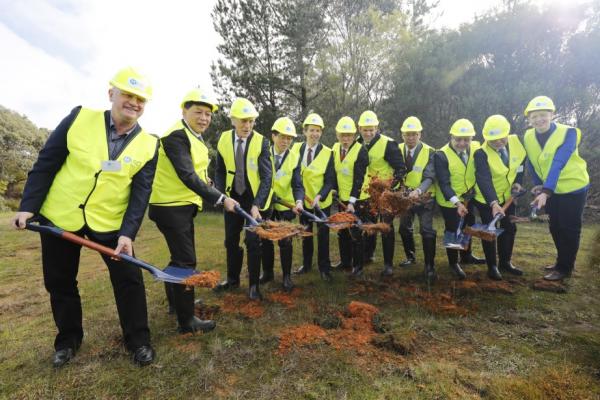Latrobe Valley hydrogen generation pilot
As the Chair of the Hydrogen Working Group developing Australia’s National Hydrogen Strategy, Dr Finkel was among the many distinguished guests who helped to turn the first sod to mark the start of construction of a new hydrogen liquefaction facility in the Port of Hastings in Victoria on Friday 19 July 2019.
The facility is part of the Hydrogen Energy Supply Chain (HESC) Pilot Project. The HESC pilot is a world’s first demonstration of a liquid hydrogen end-to-end supply chain: from the production of hydrogen in Victoria’s Latrobe Valley to delivery in Japan.
Minister for Resources and Northern Australia, Senator the Hon Matt Canavan, and Minister for Trade, Tourism and Investment, Senator the Hon Simon Birmingham, also got busy with the shovel to help break first ground on the project. The Ministers’ joint media release on the event is here.
Other attendees included Victorian Treasurer The Hon. Tim Pallas MLA, Japanese Ambassador to Australia His Excellency Mr Reiichiro Takahashi, senior industry partners, and federal, state and local government representatives.
Photo L-R: Mr Nigel Browne, General Manager AGL Loy Yang, AGL; Mr Seiichi Kuwata, President and CEO, Marubeni Corporation; Dr Alan Finkel, Australia’s Chief Scientist; Dr. Hiroshi Sasatsu, Executive Managing Officer, J-POWER; Senator the Hon Simon Birmingham, Minister for Trade, Tourism and Investment; Mr Shigeru Murayama, Global Chair, Kawasaki Heavy Industries; Senator The Hon Matthew Canavan, Minister for Resources and Northern Australia; His Excellency Reiichiro Takahashi, Ambassador of Japan to Australia; The Hon. Tim Pallas MLA, Victorian Treasurer, Minister for Economic Development, Minister for Industrial Relations; Mr Satoshi Watanabe, General Manager and Member of the Board, Iwatani Corporation; and Dr Amanda Caples, Victoria’s Lead Scientist.
The Hydrogen Working Group was established by the Council of Australian Governments (COAG) Energy Council in December 2018. The Working Group has conducted extensive stakeholder consultation and in July released a series of thematic issues papers on aspects of the emerging hydrogen economy.
The priority for the Working Group for the second half of the year will be to deliver a National Hydrogen Strategy to COAG Energy Council in December.
At the sod-turning, Dr Finkel emphasised the importance of expanding our energy mix into the future.
“A lack of diversity in energy sources puts us at risk. If, along with solar and wind energy, we can use brown coal as one way of making hydrogen – without carbon dioxide emissions during production – then it will add a third form of clean energy to the mix,” Dr Finkel said.
“This will greatly increase the diversity of our future energy supply. This, to me, is the multi-generational importance of this Victorian project.”

